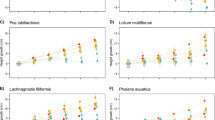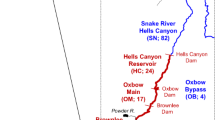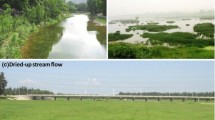Abstract
Riparian zones are some of the most valuable and at the same time endangered ecosystems in the world. Their progressive degradation caused by anthropogenic pressure calls for the adoption of effective, resilient restoration strategies. However, a full understanding of the complex mechanisms governing riparian ecosystems has not yet been achieved, and many assumptions are based on qualitative findings. We quantitatively investigated the habitat conditions of a key riparian plant, the German tamarisk (Myricaria germanica), using a two-dimensional hydrodynamic model that was created for a braided reach of the river Sense (Switzerland). The results demonstrate that the presence of this species in gravel bar habitats is strongly correlated with inundation frequency. The species was present on gravel bars near the main river channels, which are inundated every 4–5 years. Where the gravel bars are frequently flooded, seedlings do not survive the hydrodynamic perturbations, whereas elsewhere, where periodic flooding does not reach, M. germanica is replaced by stronger competitors. Our study contributes to an understanding of the dynamics of riparian corridors and provides a quantitative basis for developing effective restoration plans, which may involve the optimisation of hydropower regulation programmes.









Similar content being viewed by others
References
Armanini A (2005) Principi di idraulica fluviale. Editoriale Bios.
Baptist MJ, Babovic V, Rodríguez Uthurburu J, Keijzer M, Uittenbogaard RE, Mynett A, Verwey A (2007) On inducing equations for vegetation resistance. J Hydraul Res 45(4):435–450
Beffa C (2004) 2D-Strömungssimulation mit FLUMEN. ÖWAV-Seminar “Fließgewässermodellierung – von der Ein- zur Mehrdimensionalität?”. Wiener Mitteilungen. BOKU Wien
Benkler C, Bregy J (2010) Myricaria germanica: Experiments regarding seed germination and water stress. ETH Zürich und WSL Birmensdorf. http://www.wsl.ch/land/products/rhone-thur/rivermanagement/pdf/BenklerBregy_SA10.pdf, p 45
Bertoldi W, Siviglia A, Tettamanti S, Toffolon M, Vetsch D, Francalanci S (2014) Modeling vegetation controls on fluvial morphological trajectories. Geophys Res Lett 41:7167–7175. doi:10.1002/2014GL061666
Bill HC, Spahn P, Reich M, Plachter H (1997) Bestandesveränderungen und Besiedlungsdynamik der Deutschen Tamariske, Myricaria germanica (L.) Desv., an der Oberen Isar (Bayern). Zeitschrift für Ökologie und Naturschutz 8:137–150
Bornette G, Tabacchi E, Hupp C, Puijalon S, Rostan JC (2008) A model of plant strategies in fluvial hydrosystems. Freshw Biol 53:1692–1705. doi:10.1111/j.1365-2427.2008.01994.x
Brownlie WR (1981) Compilation of alluvial channel data: laboratory and field. California Institute of Technology California, Report no. KH-R-43B.
Camporeale C, Ridolfi L (2006) Riparian vegetation distribution induced by river flow variability: A stochastic approach. Water Resourc Res 42(10):W10415. doi:10.1029/2006WR004933
Camporeale C, Perucca E, Ridolfi L, Gurnell AM (2013) Modeling the interactions between river morphodynamics and riparian vegetation. Rev Geophys 51:379–414. doi:10.1002/rog.20014
Casas-Mulet R, Alfredsen K, Killingtveit A (2014) Modelling of environmental flow options for optimal Atlantic salmon, Salmo salar, embryo survival during hydropeaking. Fish Manage Ecol 21:480–490
Chow VT (1959) Open-Channel Hydraulics. McGraw-Hill, New York
Corenblit D, Tabacchi E, Steiger J, Gurnell A (2007) Reciprocal interactions and adjustments between fluvial landforms and vegetation dynamics in river corridors : a review of complementary approaches. Earth Sci Rev 84:56–86
Crouzy B, Edmaier K, Pasquale N, Perona P (2013) Impact of floods on the statistical distribution of riverbed vegetation. Geomorphology 202:51–58
De Silva K, Tanaka N, Yagisawa J (2013) Return period of flood disturbance that increases diversity on gravel bars in middle stream of rivers. Landsc Ecol Eng. doi:10.1007/s11355-013-0229-4
Egger G, Angermann K, Gruber A (2010) Wiederansiedlung der Deutschen Tamariske (Myricaria germanica (L.) Desv.) in Kärnten. Karinthia II 200/120:393–418
Egger G, Politti E, Garofano-Gomez V, Blamauer B, Ferriere T, Rivaes R, Benjankar R, Habersack H (2013) Embodying interactions between riparian vegetation and fluvial hydraulic processes within a dynamic floodplain model: concepts and applications. In: Maddock I, Harby A, Kemp P, Wood P (eds) Ecohydraulics: an integrated approach. Wiley, Chichester, pp 407–427
Endress PK (1975) Verbreitungsrückgang von Myricaria germanica Desv. und Typha minima Hoppe auf der Alpennordseite Graubündens. Vierteljahrsschrift der Naturforschenden Gesellschaft in Zürich 120:1–14
EU WFD (2000) Establishing a framework for Community action in the field of water policy, Directive 2000/60/EC of the European Parliament and of the Council of 23 October 2000. The European Parliament and the Council of the European Union
FISRWG (1998) Stream corridor restoration: principles, processes, and practices. By the Federal Interagency Stream Restoration Working Group. GPO Item No. 0120-A. ISBN-0-934213-59-3
Friedman JM, Auble GT (1999) Mortality of riparian box elder from sediment mobilization and extended inundation. Regul Rivers Res Manage 15:463–476
Giller PS (2005) River restoration: seeking ecological standards. Editor’s introduction. J Appl Ecol 42:201–207
Gonzalez E, Gonzalez-Sanchis M, Cabezas A, Comin FA, Muller E (2010) Recent changes in the riparian forest of a large regulated Mediterranean river: implications for management. Environ Manage 45:669–681
Gonzalez E, Gonzalez-Sanchis M, Comín FA, Muller E (2012) Hydrologic thresholds for riparian forest conservation in a regulated large Mediterranean river. River Res Appl 28(1):71–80. doi:10.1002/rra.1436
Gostner W (2012) The Hydro-Morphological Index of Diversity: a planning tool for river restoration projects. Communication 51 of the Laboratory of Hydraulic Constructions (LCH), Ecole polytechnique fédérale de Lausanne (EPFL), Ed. A. Schleiss, Lausanne
Gostner W, Parasiewicz P, Schleiss AJ (2013) A case study on spatial and temporal hydraulic variability in an alpine gravel-bed stream based on the hydromorphological index of diversity. Ecohydrology 6(4):652–667
Gurnell AM, Bertoldi W, Corenblit D (2012) Changing river channels: the roles of hydrological processes, plants and pioneer fluvial landforms in humid temperate, mixed load, gravel bed rivers. Earth-Sci Rev 111(1–2):129–141
Hauer C, Unfer G, Graf W, Leitner P, Zeiringer B, Habersack H (2012) Hydro-morphologically related variance in benthic drift and its importance for numerical habitat modelling. Hydrobiologia 683(1):83–108
Jansson R, Nilsson C, Dynesius M, Andersson E (2000a) Effects of river regulation on river-margin vegetation: A comparison of eight boreal rivers. Ecol Appl 10:203–224
Jansson R, Nilsson C, Renofalt B (2000b) Fragmentation of riparian floras in rivers with multiple dams. Ecology 81:899–903
Junk WJ, Bayley PB, Sparks RE (1989) The flood pulse concept in river-floodplain systems. Can Spec Publ Fish Aquat Sci 106:110–127
Kellerhals R, Neill CR, Bray DI (1972) Hydraulic and geomorphic characteristics of rivers in Alberta. Alberta Research Council, Edmonton, Alberta, p 52
Kudrnovsky H (2013) Alpine rivers and their ligneous vegetation with Myricaria germanica and riverine landscape diversity in the Eastern Alps: proposing the Isel river system for the Natura 2000 network. eco.mont Journal on Protected Mountain Areas. Res Manag 5:5–18
Kudrnovsky H, Stöhr O. (2013) Myricaria germanica (L.) Desv - historisch und aktuell in Österreich: Ein dramatischer Rückgang einer Indikatorart von europäischem Interesse. Stapfia 99:13–34
Lanz T, Stecher R (2009) Untersuchungen zur Samenproduktion und -ausbreitung einer Kleinpopulation von Myricaria germanica an der Sense. IKAÖ Bern und WSL Birmensdorf. http://www.wsl.ch/land/products/rhone-thur/rivermanagement/pdf/LanzStecher_PA2009.pdf, p 91. Accessed 18 Jan 2017
Lener VFP, Egger G, Karrer G (2013) Sprossaufbau und Entwicklung der Deutschen Tamariske (Myricaria germanica) an der Oberen Drau (Kärnten, Österreich). Karinthia II 203/123:515–552
Lorang MS, Hauer FR (2006) Fluvial geomorphic processes. In: Hauer FR, Lamberti GA (eds) Methods in stream ecology, 2nd edn. Elsevier Academic, San Diego, 877 pp
Michielon B, Sitzia T (2010) Presenza di Myricaria germanica (L.) Desv. lungo il torrente Avisio (Trentino, Italia Settentrionale). Annali Museo Civico Rovereto 26:319–346
Montgomery DR, Buffington JM (1997) Channel-reach morphology in mountain drainage basins. Geol Soc Am Bull 109:596–611
Müller N (2014) Wasserkraftanlagen und FFH-Lebensräume “Alpine Flüsse” unter besonderer Berücksichtigung der Deutschen Tamariske in Tirol. Naturschutzpublikationen Tirol. http://www.tirol.gv.at/umwelt/naturschutz/publikationen. Accessed 18 Jan 2017
Nepf H (2012a) Flow and transport in regions with aquatic vegetation. Annu Rev Fluid Mech 44:123–142
Nepf H (2012b) Hydrodynamics of vegetated channels. J Hydraul Res 50(3):262–279
Nilsson C, Jansson R (1995) Floristic differences between riparian corridors of regulated and free-flowing boreal rivers. Regul Rivers Res Manag 11:55–66
Nilsson C, Svedmark M (2002) Basic principles and ecological consequences of changing water regimes: riparian plant communities. Environ Manage 30(4):468–480
Palmer MA, Bernhardt ES, Allan JD, Lake PS, Alexander G, Brooks S, Carr J, Clayton S, Dahm CN, Follstad Shah J, Galat DL, Loss SG, Goodwin P, Hart DD, Hassett B, Jenkinson R, Kondolf GM, Lave R, Meyer JL, O’Donnell TK, Pagano L, Sudduth E (2005) Standards for ecologically successful river restoration. J Appl Ecol 42:208–217
Pasquale N, Perona P, Francis R, Burlando P (2012) Effects of streamflow variability on the vertical root density distribution of willow cutting experiments. Ecol Eng 40:167–172. doi:10.1016/j.ecoleng.2011.12.002
Pezeshki SR, Shields FD (2006) Black willow cutting survival in streambank plantings, Southeastern United States. J Am Water Resourc Assoc 42(1):191–200
Pfaundler M, Zappa M (2006) Die mittleren Abflüsse über die ganze Schweiz Ein optimierter Datensatz im 500 × 500 m Raster. Wasser Energie Luft Heft 4/2006:291–298
Poff NL, Allan JD, Bain MB, Karr JR, Prestegaard KL, Richter BD, Sparks RE, Stromberg JC (1997) The natural flow regime: a paradigm for river conservation and management. Bioscience 47:769–784
Pollen-Bankhead N and Simon A (2005) Estimating the mechanical effects of riparian vegetation on stream bank stability using a fiber bundle model. Water Resourc Res. doi:10.1029/2004WR003801
Pollen-Bankhead N, Simon A (2010) Hydrologic and hydraulic effects of riparian root networks on streambank stability: Is mechanical root-reinforcement the whole story? Geomorphology 116(3):353–362. doi:10.1016/j.geomorph.2009.11.013
Pringle CM, Naiman RJ, Bretschko G, Karr JR, Oswood MW, Webster JR, Welcomme RL, Winterbourn MJ (1988) Patch dynamics in lotic systems: the stream as a mosaic. J North Am Benthol Soc 7(4):503–524
Robinson CT, Uehlinger U (2003) Using artificial floods for restoring river integrity. Aquat Sci 65:181–182
Rohde S, Kienast F, Bürgi M (2004) Assessing the restoration success of river widenings: a landscape approach. Environ Manage 34:574–589
Roni P, Beechie TJ, Bilby RE, Leonetti FE, Pollock MM, Pess GR (2002) A review of stream restoration techniques and a hierarchical strategy for prioritizing restoration in Pacific Northwest watersheds. North Am J Fish Manag 22:1–20
Sadler JP, Bell D, Fowles A (2004) The hydroecological controls and conservation value of beetles on exposed riverine sediments in England and Wales. Biol Conserv 118:41–56
Schropp MHI, Bakker C (1998) Secondary channels as a basis for the ecological rehabilitation of Dutch rivers. Aquat Conserv Mar Freshw Ecosyst 8:53–59
Simonson DS, Lyons J, Kanehl PD (1994) Quantifying fish habitat in streams: transect spacing, sample size, and a proposed framework. North Am J Fish Manag 14(3):607–615
Solari L, Van Oorschot M, Belletti B, Hendriks D, Rinaldi M, Vargas-Luna A (2015) Advances on modelling riparian vegetation-hydromorphology interactions. River Res Applic 32:164–178. doi:10.1002/rra.2910.
Stanford JA, Lorang MS, Hauer FR (2005) The shifting habitat mosaic of river ecosystems. Verhandlungen der internationalen Vereinigung für theoretische und angewandte Limnologie 29:126–136
Strickler A (1923) Beiträge zur Frage der Geschwindigkeitsformel und der Rauhigkeitszahlen für Ströme, Kanäle und geschlossene Leitungen. Mitteilungen des Bundesamtes für Wasserwirtschaft, Nr. 16, Bern, 113 pp
Tanaka N, Yagisawa J (2012) Index of medium-class flood disturbance for increasing diversity of vegetation area at gravel bars or islands in middle of rivers. Int J River Basin Manag 10:255–267
Tockner K, Schiemer F (1998) Conservation by restoration: the management concept for a river-floodplain system on the Danube River in Austria. Aquat Conserv Mar Freshw Ecosyst 8:71–86
Tockner K, Stanford JA (2002) Riverine floodplains: present state and future trends. Environ Conserv 29:308–330
Tockner K, Malard F, Ward JV (2000) An extension of the flood pulse concept. Hydrol Process 14:2861–2883. doi:10.1002/1099-1085(200011/12)14:16/17<2861::AID-HYP124>3.0.CO;2-F
Turnipseed DP, Sauer VB (2010) Discharge measurements at gaging stations. U.S. Geological Survey Techniques and Methods book 3, chap. A8, 87 p. (also available at http://pubs.usgs.gov/tm/tm3-a8/.)
Werth S, Scheidegger C (2014) Gene flow within and between catchments in the threatened riparian plant Myricaria germanica. PLoS One 9:e99400. doi:10.1371/journal.pone.0099400
Werth S, Schödl M, Scheidegger C (2014) Dams and canyons disrupt gene flow among populations of a threatened riparian plant. Freshw Biol 59:2502–2515. doi:10.1111/fwb.12449
Wolman MG (1954) A method of sampling coarse bed material. Am Geophys Union Trans 35:951–956
Yalin MS (1972) Mechanics of sediment transport. 1st and 2nd edn. Pergamon, New York
Ye F, Chen Q, Blanckaert K, Ma J (2013) Riparian vegetation dynamics: insight provided by a process-based model, a statistical model and field data. Ecohydrol 6(4):567–585
Acknowledgements
This study was performed as part of the interdisciplinary research project “The integrated management of river systems”, supported by the Swiss Federal Office for Environment (http://www.rivermanagement.ch), and as part of a research project co-financed by the Autonomous Province of Bolzano, South Tyrol (Italy). Moreover, we would like to thank the reviewers for helpful comments on the different stages of the manuscript.
Author information
Authors and Affiliations
Corresponding author
Electronic supplementary material
Below is the link to the electronic supplementary material.
27_2017_535_MOESM4_ESM.tif
Regression curves relating specific flood discharge to drainage basin area between the available gauges for different return periods, used to derive the peak discharges at Plaffeien (TIF 1726 KB)
Rights and permissions
About this article
Cite this article
Gostner, W., Paternolli, M., Schleiss, A.J. et al. Gravel bar inundation frequency: an important parameter for understanding riparian corridor dynamics. Aquat Sci 79, 825–839 (2017). https://doi.org/10.1007/s00027-017-0535-2
Received:
Accepted:
Published:
Issue Date:
DOI: https://doi.org/10.1007/s00027-017-0535-2




